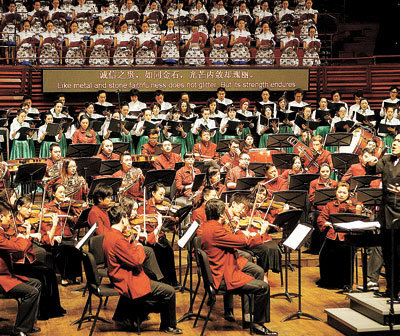|

Wang Yuanyuan
Cheekywang@hotmail.com
“ODE to Humanity” created, commissioned and composed in Shenzhen is expected to debut internationally in Paris on Sept. 21 in celebration of the International Day of Peace.
Commissioned by the Shenzhen Municipal Government, “Ode to Humanity” is a choral symphony by contemporary Chinese composer Wang Ning. Lyrics were written by Shenzhen scholars Yi Heng and Han Wangxi. The work took more than six years to complete, and uses classical music as a tool to offer a modern perspective on Confucian philosophy.
The symphony, which will be performed by Shenzhen Symphony Orchestra, Shenzhen Symphony Orchestra Chorus and Shenzhen Senior High School Lily Children’s Choir, will begin a program of events compiled by UNESCO to commemorate the International Day of Peace.
The magnificent and grand composition introduces traditional Chinese humanism, and promotes new modern Chinese humanism echoing the theme of the UNESCO events, and making it a natural choice to kick off the occasion, according to the lyricists.
Inspired by the core concepts of Confucianism, which are ren, yi, li, zhi and xin — benevolence, righteousness, propriety, wisdom and faithfulness — the symphony consists of a prelude, five movements and a coda. Over the five movements, the spirit of ren, yi, li, zhi and xin are explored and interpreted through the music.
Mixed chorus and children’s choir sections are featured in the work, especially at the beginning and end of the symphony, with their lyrics written to exemplify the brevity of ancient Chinese language.
“The great rejuvenation of the Chinese nation is the great rejuvenation of Chinese culture and civilization. Confucianism is an important part of Chinese culture and civilization. Benevolence, righteousness, propriety, wisdom and faithfulness are the core values of Confucian philosophy. And, we believe these five values are the best representatives of humanity. They have strong influences on China, and even the world. It contains the philosophy for life and society, helping people build a beautiful world. Therefore, these five factors become the five movements of the symphony,” said lyric writer Yi Heng.
Confucianism believes that when all these qualities are present, one can truly be identified as a “junzi,” which means a morally superior human being. Chinese people have pursued the goal of becoming a “junzi” for thousands of years.
In China, it is said that music can deliver emotions that cannot be described by words. Music is an international language which can be understood by all. The form of symphony is the best carrier to express the essences of Confucianism and pass on the spirits, according to the lyricists. “As a popular Western music form, symphonies can easily be understood by Western audiences who have a predisposition to the art form,” lyricist Yi Heng said.
Wang Jingsheng, head of the CPC Shenzhen Municipal Committee’s publicity department, proposed to create the symphony around 2006, hoping to better introduce Confucian philosophy and Chinese civilization to the world.
Lyrics for the “Ode to Humanity” were finally published in Shenzhen, in 2010, and the Shenzhen Municipal Government invited Wang Ning to compose the symphony.
Wang, well-known Chinese composer and director of the Composition Department at China Conservatory of Music in Beijing, accepted the task immediately. In order to collect material, find inspiration, and better understand the spirits of Confucius and Confucianism he went to Qufu, hometown of Confucius, six times. He finally finished three versions of the symphony, and after consideration it was decided the version with the chorus at the end best exemplified the intentions for the symphony.
The lyricists said they wanted to make the end like “Ode to Joy,” and the lyrics show the theme of the symphony — a world of universal harmony.
Shenzhen Symphony Orchestra
Established in 1982, Shenzhen Symphony Orchestra is among the best symphony orchestras in China. Over the past 31 years, the orchestra has accumulated a rich repertoire of different styles, and mastery of famous musical pieces by various composers. Each year, the orchestra performs more than 100 concerts which are among the best received by audiences in China. It is also the first Chinese orchestra to have performed at both the prestigious Berlin Philharmonic Hall and the Smetana Hall in Prague.
Shenzhen Senior High School Lily Children’s Choir
Founded in 1997, Shenzhen Senior High School Lily Children’s Choir is hailed as the “pride of Shenzhen” and also the “cultural name card of Shenzhen.” It consists of students from Shenzhen Senior High School.
The children of the choir seek, through their simple performances and natural sound, to become a bridge to communicate with the rest of the world . Over the past 10 years, they have performed around the world. In 2011, the choir visited the United States and held a special concert in the Kennedy Center for the Performing Arts in Washington.
|

